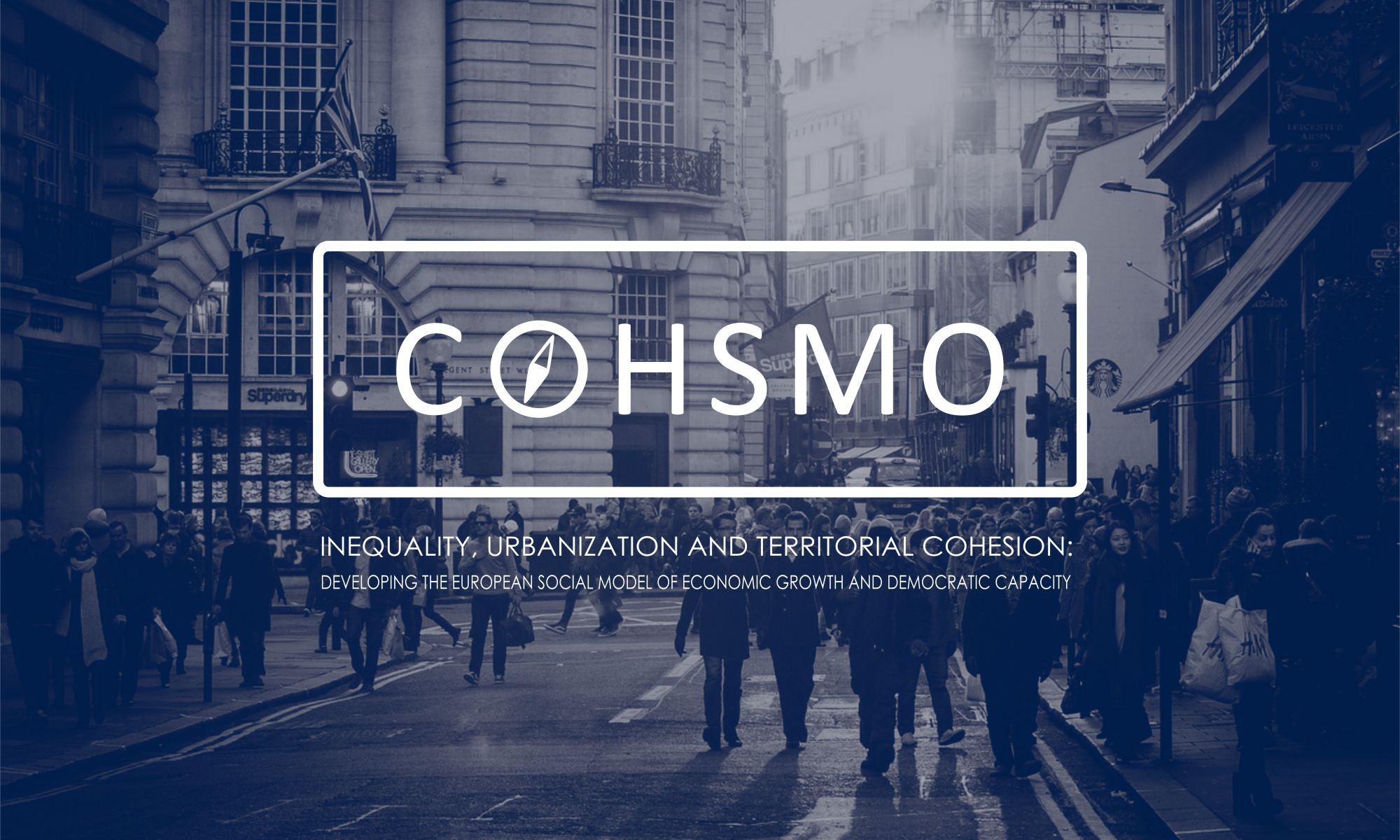COHSMO – Inequality, Urbanization and Territorial Cohesion: Developing the European Social Model of Economic Growth and Democratic Capacity
Inequality is rising across Europe; manifesting itself as socioeconomic differences between neighbourhoods, between cities and regions. This makes it pertinent to investigate the multiple ways in which location matters – not only in terms of life chances for the individual, but also in terms of the systematic way that topological differences map onto social differences characterizing variations in collective conditions of social and material well-being, as well as health inequalities (Maijer et al. 2013).
The relation between economic inequality and territorial and social differences is complex. Therefore, to gain an understanding of this complex relation, we need not only better tools and concepts with which to grasp these differences, but also a better understanding of how and why different governmental programmes and governmental relations might intervene in and mediate between such differences, and especially the role of local belonging and community relations in this regard (Böhme et al. 2011).
Therefore, the principal aim of COHSMO is to investigate the relation between socioeconomic structures of inequality, urbanization and territorial cohesion, and how territorial cohesion at different European scales affect economic growth, spatial justice and democratic capacities.
Across Europe, we see pockets of growth areas adjacent to areas of decline. Processes of demographic change and urbanization directing flows of people and investments to particular regions create areas of service exclusion, and thus, in some instances, these processes even out any mediating effects from social investment strategies. Territorial cohesion at local, regional and national scale is increasingly being challenged by increasing hyper-diversity and segregation, both of which minimize interaction across social and cultural backgrounds. In some instances, this might undermine solidarity with other socialn groups and across scales, and hence challenge the democratic capacities and legitimacy behind public investments at different levels. Thus, the interactions between policy programmes, structures of inequality and territorial cohesion are complex and have specific local outcomes. We need to develop our knowledge of these interactions, not only in terms of recommendations for bringing about sustainable economic growth, but also because such konwledge can be viewed as the foundation for developing the European social model.
A decade of economic crisis and austerity measures has exaggerated already existing locational differences and created new ones as mediating, publicly funded initiatives have been rolled back in many European countries to cut public expenditure. Even though in the last two decades we have witnessed the emergence of a “social investment state” (Morel, Palier and Palme 2012) emphasising public investment in human capital and the role of social policy in delivering economic growth, such strategies have very different regional forms. While they were primarily developed in the Nordic countries, Southern and Continental Europe has also embraced these strategies to a lesser degree. Moreover, low growth rates and pressure to reduce public spending have reduced the willingness to maintain and develop burgeoning ideas of social investment. More knowledge is needed on how social investment strategies interact with local conditions, as patterns of territorial cohesion create both inertia and fertile conditions for local innovations supporting regional and national, as well as supra-national growth strategies.
Studying how location matters through focusing on relations between inequality, urbanization and territorial cohesion, COHSMO will develop new angles of the relationship between territorial cohesion and economic growth, spatial justice and democratic capacities. Moreover, the project will develop a set of policy recommendations for how policy instruments at different scales can intervene in these relations.
To investigate these challenges outlined above, a multi-method set-up and consortium with a broad spectrum of expertise ranging across different disciplines and different methodologies is needed. The consortium behind COHSMO will combine demographic investigations, ethnographies, statistics, surveys and mapping in comprehensive analyses of inequality, urbanization and territorial cohesion. Statistical enquiry and policy analysis will be combined with an analysis of the layers of interaction, community and sense of belonging which play important parts in the understanding of how place influences opportunity, in terms of growth as well as individual life chances. The consortium consists of expertise that not only crosses disciplines, but also crosses structural, political and micro-level perspectives. This expertise will provide the project with cross-sectorial and multilevel explanations and conceptual developments which will be essential in order to answer the question of how location matters for inequality.
References:
Böhme, Kai, Philipe Doucet, Tomasz Komornicki, Jacek Zaucha, Dariusz Swiatek (2011): How to strenghten the territorial dimension of “Europe 2020” and the EU Cohesion Policy. Warsaw: European Union _European Regional Development Fund.
Maijer, M., K. Bloomfield & G. Engholm (2012): Neighbourhoods matter too: the association between neighbourhood, socioeconomic position, population density and breast, prostate and lung cancer incidence in Denmark between 2004 and 2008. In: Journal of Epidemiology and Community Health; Published Online First: 23 July 2012 doi: 10.1136/jech-2011-200192
Morel, N., Palier, B., & Palme, J. (2012) Beyond the welfare state as we knew it. In Morel, N., Palier, B., & Palme, J. (eds.) Towards a social investment welfare state, Bristol, Policy Press, 1-30.
